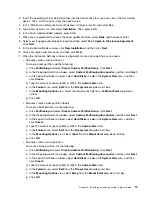
3. Insert the operating system installation disc into the optical drive that you have set as the first startup
device. Then, start the server from the optical drive.
4. In the “SUSE Linux Enterprise Server Welcome” window, press F5 and select
Yes
.
5. Type
brokenmodules=isci
and select
Installation
. Then, press Enter.
6. In the Driver Update added window, press Enter.
7. When you are prompted to choose the driver update medium, select
Back
and then press Enter.
8. Select your language and keyboard layout and then select
Yes, I Agree to the License Agreement
.
Click
Next
.
9. In the Installation Mode window, click
New Installation
, and then click
Next
.
10. Verify your region and time zone, and then click
Next
.
11. When the Installation Settings window is displayed, create a drive partition as you need.
• Manually create a root partition (/)
To create a root partition, do the following:
a. Click
Partitioning
and select
Create Custom Partition Setup
. Click
Next
.
b. In the Preparing Hard Disk window, select
Custom Partitioning (for experts)
, and then click
Next
.
c. In the Expert Partitioner window, select
Hard Disks
➙
sda
in the
System View
area, and then
click
Create
.
d. Type the amount of space (in MB or GB) in the
Custom Size
field.
e. In the
Format
area, select
Ext3
from the
File system
drop-down list box.
f. In the
Mounting Options
area, select the forward slash
(/)
from the
Mount Point
drop-down
list box.
g. Click
OK
.
• Manually create a boot partition (/boot)
To create a boot partition, do the following:
a. Click
Partitioning
and select
Create Custom Partition Setup
. Click
Next
.
b. In the Preparing Hard Disk window, select
Custom Partitioning (for experts)
, and then click
Next
.
c. In the Expert Partitioner window, select
Hard Disks
➙
sda
in the
System View
area, and then
click
Create
.
d. Type the amount of space (in MB or GB) in the
Custom Size
field.
e. In the
Format
area, select
Ext3
from the
File system
drop-down list box.
f. In the
Mounting Options
area, select
/boot
from the
Mount Point
drop-down list box.
g. Click
OK
.
• Manually create a swap partition
To create a swap partition, do the following:
a. Click
Partitioning
and select
Create Custom Partition Setup
. Click
Next
.
b. In the Preparing Hard Disk window, select
Custom Partitioning (for experts)
, and then click
Next
.
c. In the Expert Partitioner window, select
Hard Disks
➙
sda
in the
System View
area, and then
click
Create
.
d. Type the amount of space (in MB or GB) in the
Custom Size
field.
e. In the
Format
area, select
Ext3
from the
File system
drop-down list box.
f. In the
Mounting Options
area, select
Swap
from the
Mount Point
drop-down list box.
g. Click
OK
.
Chapter 2
.
Installing an operating system in legacy mode
19
Содержание ThinkServer RD340
Страница 1: ...ThinkServer RD340 and RD440 Operating System Installation Guide ...
Страница 6: ...iv ThinkServer RD340 and RD440 Operating System Installation Guide ...
Страница 8: ...2 ThinkServer RD340 and RD440 Operating System Installation Guide ...
Страница 56: ...50 ThinkServer RD340 and RD440 Operating System Installation Guide ...
Страница 68: ...62 ThinkServer RD340 and RD440 Operating System Installation Guide ...
Страница 69: ......
Страница 70: ......






























